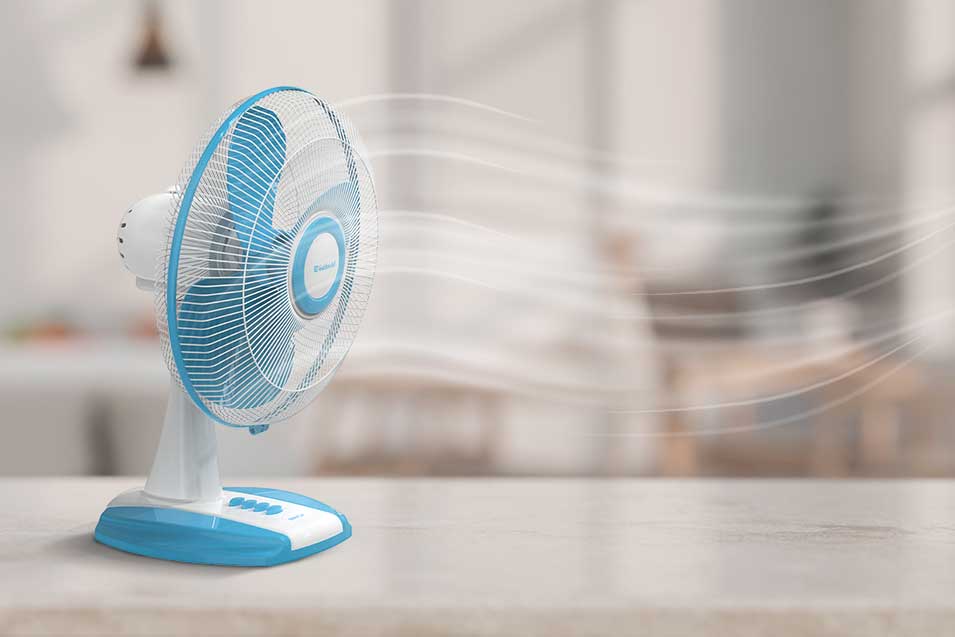
Explore the Table Fan’s Operating Principle
Introduction
In the midst of our fast-paced lives, we often overlook the simple technologies that make our daily routines more comfortable. One such marvel of convenience is the table fan. In this blog post, we’ll explore the workings of table fans, breaking down their operation in a way that’s easy to understand. As we delve into this journey, let’s appreciate the genius behind this everyday appliance.
The Basic Mechanics
At its core, a table fan consists of blades attached to and powered by an electric motor. When you switch on the fan, electricity energizes the motor, which in turn rotates the blades. The design and angle of these blades are crucial; they are crafted to pull air in from behind the fan and push it outwards in front of the fan creating a breeze that cools the immediate area.
The Role of the Motor
The electric motor is the heartbeat of the table fan. It converts electrical energy into mechanical energy. This motor is typically a single-phase induction motor. It’s reliable, efficient, and perfectly suited for the job of running for hours without overheating or needing a break.
Speed Control Mechanism
One of the key features of a table fan is the ability to control its speed. This is usually achieved through a capacitor-based speed control mechanism. By adjusting the fan’s speed, you can control the amount of air flow, thereby regulating the cooling effect to suit your comfort.
Oscillation Feature
Most table fans come with an oscillation feature. This is a pivotal aspect of the fan’s design, allowing it to rotate back and forth, even oscillate upwards and downwards distributing air over a wider area. The oscillation mechanism works through a gearbox connected to the motor, which, when activated, causes the fan to swing from side to side.
Safety Features
Safety in design is paramount. The external cage or grill of the fan is not just an aesthetic feature; it serves the crucial function of protecting fingers from the moving blades. Additionally, many modern fans come with thermal overload protectors to prevent overheating.
Energy Efficiency
Table fans are generally energy efficient. They consume far less power compared to air conditioners, making them an eco-friendlier option for cooling. With advancements in technology, newer models are even more energy-efficient, making them a smart choice for budget-conscious consumers.
Maintenance Tips
To ensure longevity and optimal performance, regular maintenance of your table fan is essential. This includes cleaning the blades and grill to prevent dust accumulation, checking for loose fittings, and ensuring the motor is well-lubricated.
Conclusion
In summary, the humble table fan is a testament to the beauty of simple engineering. Its efficient design, combined with user-friendly features, makes it an indispensable part of our daily lives. As we continue to embrace technologies that enhance our comfort, let’s not forget to appreciate the simple yet profound principles behind them. Whether in a bustling office or a cozy home, the table fan stands as a silent, steadfast ally, bringing a breath of fresh air into our spaces, compared to the other types of fans.
Frequently Asked Questions (FAQs) :
Q1. What is the purpose of the oscillation feature in a table fan?
The oscillation feature in table fans ensures widespread airflow across a larger area, enhancing comfort. It allows the fan to rotate, distributing air evenly and maintaining a consistent temperature in the room.
Q2. What safety features do table fans have?
Table fans include a stable base, a protective mesh grill, and overheating protection. These features ensure long-lasting, safe operation, keeping your safety and comfort as our top priority.
Q3. Are table fans energy-efficient?
Yes, table fans are energy-efficient. They consume less electricity compared to air conditioners, offering an eco-friendly and cost-effective way to stay cool. Many designs maximize airflow while minimizing energy usage.
Q4. Why choose a table fan over other cooling options?
Table fans are portable, affordable, and effective. Ideal for personal use, they offer immediate relief from heat, require minimal space, and are a budget-friendly alternative to other cooling methods.
Q5.Can table fans be used in conjunction with air conditioners?
Absolutely. Table fans can be used alongside air conditioners to enhance cooling efficiency. They help circulate cool air more evenly, potentially reducing energy consumption and lowering thermostat settings.
Q6. What makes table fans a valuable addition to daily life?
Table fans are versatile, affordable, and convenient, making them a valuable addition to any home. They offer quick cooling solutions, are user-friendly, and can be used in various settings for comfort during hot days.ating for cleaner industrial processes, collectively complement the effectiveness of air purifiers in creating a healthier environment.

